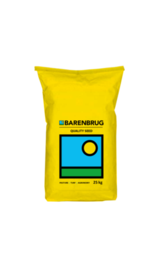Stands tall against the competition
Oceanic climate ✓
Mediterranean ✓
If you are looking for annual pasture that quickly produces plenty of tasty forage, Westerwold ryegrass is the right choice for you. Bartimum is a tetraploid Westerwold ryegrass from the Barenbrug breeding program in southern France. It excels in consistently high production, sod density and disease resistance.
Constant high production
Westerwold ryegrass is characterised by its very quick establishment and high productivity in a short time frame. These properties are enhanced in Bartimum.
Healthier silage
Another striking feature of the research in Cropvale is Bartimum's high sod density. This yields healthier forage. Weeds have no chance with its dense sods. As a result, the forage contains fewer weeds and less sand. Finally, the sod density prevents moisture evaporation from the soil. As a result, Bartimum is more resistant to drought.
Excellent disease resistance
Bartimum is the result of many years of breeding in Barenbrug France, whereby, in addition to high production and sod density, we selected for excellent resistance to lodging and the most common grass diseas .



